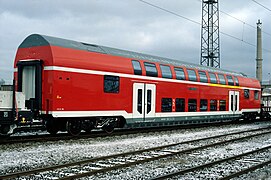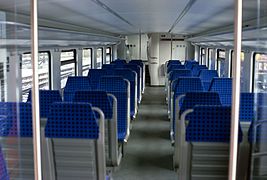DB class 445 (1998)
| 445 001/501 | |
|---|---|
| Numbering: | 445 001/845 001/445 501 |
| Number: | 1 |
| Manufacturer: | DWA , Adtranz , Siemens |
| Year of construction (s): | 1998 |
| Retirement: | 2006 |
| Axis formula : | Bo'Bo '+ 2'2' + Bo'Bo ' |
| Gauge : | 1435 mm ( standard gauge ) |
| Length over coupling: | 82,270 mm |
| Empty mass: | 179 tons |
| Top speed: | 140 km / h |
| Continuous output : | 3600 kW |
| Acceleration: | 1.0 m / s² |
| Motor type: | 1TB 2016 |
| Power system : | 15 kV, 16.7 Hz ~ |
| Power transmission: | Overhead line |
| Number of traction motors: | 8th |
| Control: | Multiple control MESA 2002, DAVIS, MVB |
| Seats: | 289 |
The 445 001/501 was a three-part double-decker multiple unit (class 445.0 / 845 / 445.5) from the double-decker vehicle concept developed by DWA Görlitz (now Bombardier Transportation ) for the S-Bahn and regional traffic of Deutsche Bahn .
background
Only a prototype of the railcar was produced with the financial participation of the state of Saxony, the railways and the multiple unit work group (DWA-Siemens- Adtranz ). At Siemens Transportation Systems , a company involved in the development of the ARGE , the 445 series belonged to the Desiro - “Double Deck” concept, from which the Swiss RABe 514 later emerged.
This multiple unit, also known as the "Meridian", was commissioned in 1996 and presented in 2000 by Deutsche Bahn. Adtranz and Siemens (with an order volume of around five million euros) were responsible for the electrical part and DWA was responsible for the mechanical part.
In the wagon construction part, the Meridian was derived from the double-decker cars of the DWA Görlitz, but the car bodies were made of aluminum instead of steel construction. The drive technology contained relatively voluminous components from locomotive construction , so that there were no seats above the bogies of the railcars . The concept provided for trains from new railcars with existing double-decker and control cars of a more modern design (with conversion to a central buffer coupling and adaptation of the control technology) in the case of series procurement . The possibility of using it in the S-Bahn networks of Dresden and Leipzig-Halle was examined.
After a test phase and various modifications (including to the running gear ), the train was not put into scheduled service by the DB despite the EBA approval. Since 2003 it has been parked at Bombardier Transportation in Hennigsdorf and was dismantled in 2006.


